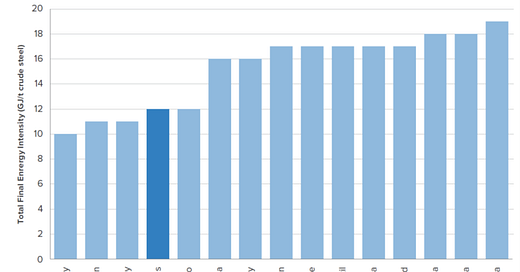Biden’s Trumpian Trade Talks With Japan
From Steel Tariffs to Cloaking Protectionism in the Garb of Fighting Climate Change
No one expected Joe Biden to have an expansive trade policy with Japan and the rest of Asia, such as reentering the Trans-Pacific Partnership (TPP), now called Comprehensive and Progressive Agreement for Trans-Pacific Partnership (CPTPP). Open trade is anathema to the majority of the Congressional delegations in both parties and Biden had to focus on domestic recovery first. However, it was to be hoped that he would lift the most obnoxious of Donald Trump’s trade offenses: the unilateral imposition of import tariffs on steel and aluminum on the grounds that America’s military allies, from Japan and Korea to Canada to Europe all posed a “national security threat” to the US under Section 232 of US trade law.
No such luck. Biden has instead used Trump’s tariffs as a bargaining chip. And, in just-concluded talks with Europe, Washington has gotten Europe to agree to replace Trump’s tariffs with what are called Tariff Rate Quotas (TRQs), using the same Section 232. Europe will be allowed to send 3.3 million tons to the US tariff-free. Anything above that will be charged the same 25% tariff rate as Trump imposed. The tariff free amount is one-third less than the 5 million tons per year the US imported from Europe prior to Trump’s diktat. Moreover, the deal will maintain restrictions on steel products from a range of countries, including America’s Asian allies—that are partly made outside of Europe but finished in Europe.
Now, US Trade Representative Katherine Tai and Commerce Secretary Gina Raimondo are off to Tokyo next week for trade talks, and reportedly will try to compel Japan to submit to the same policy to which Washington got Europe to acquiesce.
The wonder of it all is that the Biden administration blames China for a global glut of steel but punishes its allies for China’s actions. It’s hard to fathom how Biden expects to erect a global coalition on trade conflicts with China while simultaneously pursuing protectionism against US allies it wants it that coalition.
Meanwhile, the Biden administration is apparently trying to use cloak more protectionism in the garb of fighting climate change. It proposes to negotiate tariffs on steel and other products based on the intensity of its carbon emissions. It would be one thing to have a fairly negotiated multilateral deal on a wide range of products based on emissions intensity. But the Biden administration is being very selective, focusing on just a few products where the US imports a lot but exports little. Take steel, for example. In the pre-Trump era, the US imported three times as much steel as it exported. It was the world’s second largest importer but came in 17th in exports.
Back in 2016, US-made steel was the fourth least emissions-intensive steel among 15 major producers, while China and India came in the worst. However, as other countries move to renewables-based electricity, the US is likely to fall further behind and may have done so already. Meanwhile, if Japan continues relying so much on coal to produce electricity, its ranking will fall from its already low-ranking in slot 9. For a report on CO2 intensity of steel by country, see https://www.globalefficiencyintel.com/s/How-Clean-is-the-US-Steel-Industry.pdf
Other targets for carbon-based tariffs reportedly include aluminum, cement and fertilizer. The US is the world’s largest importer of cement, and imports twice as much fertilizer as it exports. The Wall Street Journal reported: George David Banks, a veteran Republican environmental policy official who worked in the Trump White House and is now promoting carbon tariffs, said, “Once Republican voters recognize that this is the way of getting our supply chain back to the U.S., I think people are going to see the climate agenda very differently.” See: https://www.wsj.com/articles/tariffs-climate-change-greenhouse-gases-manufacturing-steel-11635862305?page=1
It seems that the Biden team is trying to find a way to put together a policy combo that tries to reclaim the protectionist/nationalist voters who left the Democrats for Trump in 2016 while at the same time letting the White House claim that it is doing something on climate change to those in the Democratic voter base who want action on that front. Unfortunately, many of the Democrats who want action on climate are also opposed the open trade, seeing it as a corporate rip-off.
For a report on how Biden is continuing Trump’s trade policies without the latter’s nasty rhetoric, see Daniel Sneider’s analysis in Toyo Keizai in Japanese (https://toyokeizai.net/articles/-/464668) or English (https://toyokeizai.net/articles/-/464928).


